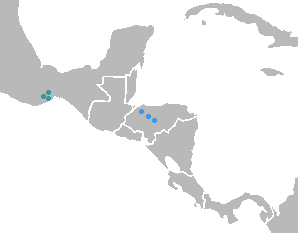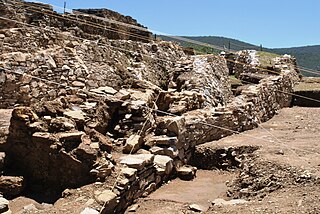
The Hokan language family is a hypothetical grouping of a dozen small language families spoken mainly in California, Arizona, and Baja California.

Penutian is a proposed grouping of language families that includes many Native American languages of western North America, predominantly spoken at one time in British Columbia, Washington, Oregon, and California. The existence of a Penutian stock or phylum has been the subject of debate among specialists. Even the unity of some of its component families has been disputed. Some of the problems in the comparative study of languages within the phylum are the result of their early extinction and limited documentation.

Amerind is a hypothetical higher-level language family proposed by Joseph Greenberg in 1960 and elaborated by his student Merritt Ruhlen. Greenberg proposed that all of the indigenous languages of the Americas belong to one of three language families, the previously established Eskimo–Aleut and Na–Dene, and with everything else—otherwise classified by specialists as belonging to dozens of independent families—as Amerind. Due to a large number of methodological flaws in the 1987 book Language in the Americas, the relationships he proposed between these languages have been rejected by the majority of historical linguists as spurious.

Mesoamerican languages are the languages indigenous to the Mesoamerican cultural area, which covers southern Mexico, all of Guatemala, Belize, El Salvador, and parts of Honduras, Nicaragua and Costa Rica. The area is characterized by extensive linguistic diversity containing several hundred different languages and seven major language families. Mesoamerica is also an area of high linguistic diffusion in that long-term interaction among speakers of different languages through several millennia has resulted in the convergence of certain linguistic traits across disparate language families. The Mesoamerican sprachbund is commonly referred to as the Mesoamerican Linguistic Area.

Uto-Aztecan, Uto-Aztekan is a family of indigenous languages of the Americas, consisting of over thirty languages. Uto-Aztecan languages are found almost entirely in the Western United States and Mexico. The name of the language family was created to show that it includes both the Ute language of Utah and the Nahuan languages of Mexico.

The Oto-Manguean or Otomanguean languages are a large family comprising several subfamilies of indigenous languages of the Americas. All of the Oto-Manguean languages that are now spoken are indigenous to Mexico, but the Manguean branch of the family, which is now extinct, was spoken as far south as Nicaragua and Costa Rica. Oto-Manguean is widely viewed as a proven language family.

This is a list of different language classification proposals developed for the Indigenous languages of the Americas. The article is divided into North, Central, and South America sections; however, the classifications do not correspond to these divisions.

The Yuman–Cochimí languages are a family of languages spoken in Baja California, northern Sonora, southern California, and western Arizona. Cochimí is no longer spoken as of the late 18th century, and most other Yuman languages are threatened.
Paezan may be any of several hypothetical or obsolete language-family proposals of Colombia and Ecuador named after the Paez language.

Tequistlatec languages, also called Chontal, are three close but distinct languages spoken or once spoken by the Chontal people of Oaxaca State, Mexico.
Paleolinguistics is a term used by some linguists for the study of the distant human past by linguistic means. For most historical linguists there is no separate field of paleolinguistics. Those who use the term are generally advocates of hypotheses not generally accepted by mainstream historical linguists, a group colloquially referred to as "long-rangers".

Proto-Mayan is the hypothetical common ancestor of the 30 living Mayan languages, as well as the Classic Maya language documented in the Maya inscriptions. While there has been some controversy with Mayan subgrouping, there has been a general agreement that the following are the main five subgroups of the family: Huastecan, Yucatecan, Cholan-Tzeltalan, Kanjobalan-Chujean, and Quichean-Mamean.
Subtiaba is an extinct Oto-Manguean language which was spoken on the Pacific slope of Nicaragua, especially in the Subtiaba district of León. Edward Sapir established a connection between Subtiaba and Tlapanec. When Lehmann wrote about it in 1909 it was already very endangered or moribund.

The Supanecan or Tlapanecan languages are Tlapanec (Me'phaa) of Guerrero and the extinct Subtiaba of Nicaragua. The family was recognized in 1925 by Edward Sapir, who linked them to his Hokan proposal. However, they are the most recently recognized members of the Oto-Manguean language family, the relationship having been demonstrated in 1977 by Jorge Suárez. The Oto-Manguean affiliation of Tlapaneco-Subtiaba is supported by Kaufman (2016).

Tolatecan is a proposal by Campbell and Oltrogge (1980) linking two language families of Mesoamerica, Tequistlatecan and Tol/Jicaque languages of Honduras. Later, Campbell (1997) said that Tolatecan is not likely to be a valid language family.
Tol (Tolpan), also known as Eastern Jicaque, Tolupan, and Torupan, is spoken by approximately 500 Tolupan people in La Montaña de la Flor reservation in Francisco Morazán Department, Honduras.

Ixcateopan is an archaeological site located in the town and municipality of Ixcateopan de Cuauhtémoc, 36 kilometers from Taxco, in the isolated and rugged mountains of the northern part of the Mexican state of Guerrero.
Proto-Uto-Aztecan is the hypothetical common ancestor of the Uto-Aztecan languages. Authorities on the history of the language group have usually placed the Proto-Uto-Aztecan homeland in the border region between the United States and Mexico, namely the upland regions of Arizona and New Mexico and the adjacent areas of the Mexican states of Sonora and Chihuahua, roughly corresponding to the Sonoran Desert and the western part of the Chihuahuan Desert. It would have been spoken by Mesolithic foragers in Aridoamerica, about 5,000 years ago.
Western Jicaque, also known as Jicaque of El Palmar and Sula, now extinct, was a Jicaquean language spoken around El Palmar, Cortés Department, near Chamelecón in Honduras. It was attested in wordlists from the 1890s.
The Takelma–Kalapuyan languages are a proposed small language family that comprises the Kalapuyan languages and Takelma, which are spoken in the Willamette Valley and the Rogue Valley in the U.S. state of Oregon.












